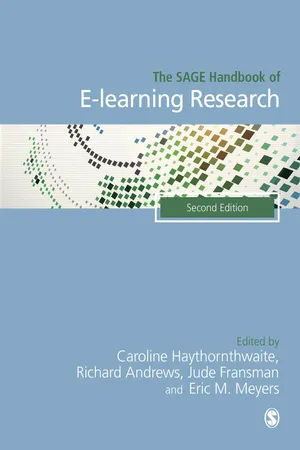
The SAGE Handbook of E-learning Research
Caroline Haythornthwaite,Richard Andrews,Jude Fransman,Eric M. Meyers
- 606 páginas
- English
- ePUB (apto para móviles)
- Disponible en iOS y Android
The SAGE Handbook of E-learning Research
Caroline Haythornthwaite,Richard Andrews,Jude Fransman,Eric M. Meyers
Información del libro
The new edition of The SAGE Handbook of E-Learning Research retains the original effort of the first edition by focusing on research while capturing the leading edge of e-learning development and practice. Chapters focus on areas of development in e-learning technology, theory, practice, pedagogy and method of analysis.
Covering the full extent of e-learning can be a challenge as developments and new features appear daily. The editors of this book meet this challenge by including contributions from leading researchers in areas that have gained a sufficient critical mass to provide reliable results and practices. The 25 chapters are organised into six key areas:
1. THEORY
2. LITERACY & LEARNING
3. METHODS & PERSPECTIVES
4. PEDAGOGY & PRACTICE
5. BEYOND THE CLASSROOM
6. FUTURES
Preguntas frecuentes
Información
Part I Introduction
1 Introduction to the SAGE Handbook of E-learning Research, Second Edition
INTRODUCTION
SITUATING E-LEARNING
Índice
- Cover
- Half Title
- Title Page
- Copyright Page
- Contents
- Illustration List
- List of Tables
- Notes on the Editors and Contributors
- Acknowledgements
- Part I Introduction
- 1 Introduction to the SAGE Handbook of E-learning Research, Second Edition
- Part II Theory
- 2 Online Pedagogy from the Learning Sciences Perspective
- 3 Networked Learning
- 4 A Theory of Learning for the Mobile Age
- 5 Posthumanism and Research in Digital Education
- Part III LITERACY AND LEARNING
- 6 Reshaping Rhetorical Space: E-learning through Online Asynchronous Discussion
- 7 Liber Ludens: Games, Play and Learning
- 8 Multimodality in Virtual Learning Environments: Exploring Traces of the Page in Designs of Screens
- 9 Second Language Learning Online
- 10 Multilingualism and E-learning
- Part IV Methods and Perspectives
- 11 The Ethics of Learning and Technology Research
- 12 Learning Analytics and the Imperative for Theory-Driven Research
- 13 A Social Network Analytic Perspective on E-Learning
- 14 Analyzing Learning in Online Discussions
- 15 Multimodal Longitudinal Journaling
- Part V Pedagogy and Practice
- 16 Information Literacy and Information Practice
- 17 Design for E-learning
- 18 Social Media and Learning
- 19 Games and Learning
- 20 Pedagogies in Virtual Worlds
- Part VI Beyond the Classroom
- 21 Literacy and the Digital University
- 22 Promoting Policy Uptake for Open Educational Resources and Open Practices
- 23 E-learning and Libraries
- 24 E-learning in Museums
- 25 Designing for Lifelong Learning
- Part VII Futures
- 26 The Future of E-learning
- Index